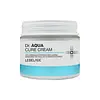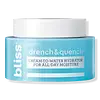What's inside
What's inside
 Key Ingredients
Key Ingredients

 Benefits
Benefits

 Concerns
Concerns

 Ingredients Side-by-side
Ingredients Side-by-side

Water
Skin ConditioningGlycerin
HumectantDipropylene Glycol
HumectantCyclopentasiloxane
EmollientCyclohexasiloxane
EmollientDimethicone
EmollientSodium Chloride
MaskingCetyl PEG/PPG-10/1 Dimethicone
EmulsifyingDimethicone/Vinyl Dimethicone Crosspolymer
Skin ConditioningPhenoxyethanol
PreservativeChlorphenesin
AntimicrobialAllantoin
Skin ConditioningTocopheryl Acetate
AntioxidantParfum
MaskingUndaria Pinnatifida Extract
Skin ConditioningAdenosine
Skin Conditioning1,2-Hexanediol
Skin ConditioningDisodium EDTA
Butylene Glycol
HumectantSodium Hyaluronate
HumectantLimonene
PerfumingCitronellol
PerfumingBenzyl Benzoate
AntimicrobialCI 42090
Cosmetic ColorantWater, Glycerin, Dipropylene Glycol, Cyclopentasiloxane, Cyclohexasiloxane, Dimethicone, Sodium Chloride, Cetyl PEG/PPG-10/1 Dimethicone, Dimethicone/Vinyl Dimethicone Crosspolymer, Phenoxyethanol, Chlorphenesin, Allantoin, Tocopheryl Acetate, Parfum, Undaria Pinnatifida Extract, Adenosine, 1,2-Hexanediol, Disodium EDTA, Butylene Glycol, Sodium Hyaluronate, Limonene, Citronellol, Benzyl Benzoate, CI 42090
Water
Skin ConditioningCyclopentasiloxane
EmollientGlycerin
HumectantButylene Glycol
HumectantDimethicone
EmollientHydrogenated Polyisobutene
EmollientSodium Acetylated Hyaluronate
HumectantSodium Hyaluronate
HumectantSodium Hyaluronate Crosspolymer
HumectantHyaluronic Acid
HumectantEthylhexylglycerin
Skin ConditioningDimethicone/PEG-10/15 Crosspolymer
Sodium Chloride
MaskingPhenoxyethanol
PreservativeBenzyl Alcohol
PerfumingSodium Citrate
BufferingDimethicone/Vinyl Dimethicone Crosspolymer
Skin ConditioningChamomilla Recutita Flower Extract
MaskingPassiflora Incarnata Seed Oil
Skin ProtectingPotassium Sorbate
PreservativeGuar Hydroxypropyltrimonium Chloride
Skin ConditioningPolysorbate 20
EmulsifyingDipropylene Glycol
HumectantTetrahexyldecyl Ascorbate
AntioxidantTocopheryl Acetate
AntioxidantSilybum Marianum Seed Oil
Skin ConditioningCaprylic/Capric Triglyceride
MaskingPorphyra Umbilicalis Extract
Skin ConditioningTocopherol
AntioxidantCommiphora Mukul Resin Extract
Skin ConditioningSaccharina Longicruris Extract
HumectantRosa Multiflora Fruit Extract
MaskingSodium Benzoate
MaskingLinalool
PerfumingAlpha-Isomethyl Ionone
PerfumingLimonene
PerfumingParfum
MaskingWater, Cyclopentasiloxane, Glycerin, Butylene Glycol, Dimethicone, Hydrogenated Polyisobutene, Sodium Acetylated Hyaluronate, Sodium Hyaluronate, Sodium Hyaluronate Crosspolymer, Hyaluronic Acid, Ethylhexylglycerin, Dimethicone/PEG-10/15 Crosspolymer, Sodium Chloride, Phenoxyethanol, Benzyl Alcohol, Sodium Citrate, Dimethicone/Vinyl Dimethicone Crosspolymer, Chamomilla Recutita Flower Extract, Passiflora Incarnata Seed Oil, Potassium Sorbate, Guar Hydroxypropyltrimonium Chloride, Polysorbate 20, Dipropylene Glycol, Tetrahexyldecyl Ascorbate, Tocopheryl Acetate, Silybum Marianum Seed Oil, Caprylic/Capric Triglyceride, Porphyra Umbilicalis Extract, Tocopherol, Commiphora Mukul Resin Extract, Saccharina Longicruris Extract, Rosa Multiflora Fruit Extract, Sodium Benzoate, Linalool, Alpha-Isomethyl Ionone, Limonene, Parfum
 Reviews
Reviews

Ingredients Explained
These ingredients are found in both products.
Ingredients higher up in an ingredient list are typically present in a larger amount.
Butylene Glycol (or BG) is used within cosmetic products for a few different reasons:
Overall, Butylene Glycol is a safe and well-rounded ingredient that works well with other ingredients.
Though this ingredient works well with most skin types, some people with sensitive skin may experience a reaction such as allergic rashes, closed comedones, or itchiness.
Learn more about Butylene GlycolCyclopentasiloxane, or D5, is a silicone used to improve texture of products and trap moisture.
D5 is considered lightweight and volatile. Volatile means it evaporates quickly after application. Once evaporated, D5 leaves a thin barrier that helps keep skin hydrated.
It is also an emollient. Emollients help soften the skin and prevent water loss. Silicones create a silky texture in products. D5 helps other ingredients become more spreadable.
Studies show D5 is safe to use in skincare products. We recommend speaking with a skincare professional if you have concerns.
Learn more about CyclopentasiloxaneDimethicone is a type of synthetic silicone created from natural materials such as quartz.
What it does:
Dimethicone comes in different viscosities:
Depending on the viscosity, dimethicone has different properties.
Ingredients lists don't always show which type is used, so we recommend reaching out to the brand if you have questions about the viscosity.
This ingredient is unlikely to cause irritation because it does not get absorbed into skin. However, people with silicone allergies should be careful about using this ingredient.
Note: Dimethicone may contribute to pilling. This is because it is not oil or water soluble, so pilling may occur when layered with products. When mixed with heavy oils in a formula, the outcome is also quite greasy.
Learn more about DimethiconeThis ingredient is a silicone used to improve the texture of products and absorb oil. It does not get absorbed into the skin.
Like other silicones, Dimethicone/Vinyl Dimethicone Crosspolymer helps condition the skin by creating a barrier. In this sense, it can act as an emollient and trap moisture in.
This ingredient is a type of elastomer.
Learn more about Dimethicone/Vinyl Dimethicone CrosspolymerDipropylene Glycol is a synthetically created humectant, stabilizer, and solvent.
This ingredient helps:
Dipropylene glycol is technically an alcohol, but it belongs to the glycol family (often considered part of the ‘good’ alcohols). This means it is hydrating and gentle on skin unlike drying solvent alcohols like denatured alcohol.
As a masking agent, Dipropylene Glycol can be used to cover the smell of other ingredients. However, it does not have a scent.
Studies show Dipropylene Glycol is considered safe to use in skincare.
Learn more about Dipropylene GlycolGlycerin is already naturally found in your skin. It helps moisturize and protect your skin.
A study from 2016 found glycerin to be more effective as a humectant than AHAs and hyaluronic acid.
As a humectant, it helps the skin stay hydrated by pulling moisture to your skin. The low molecular weight of glycerin allows it to pull moisture into the deeper layers of your skin.
Hydrated skin improves your skin barrier; Your skin barrier helps protect against irritants and bacteria.
Glycerin has also been found to have antimicrobial and antiviral properties. Due to these properties, glycerin is often used in wound and burn treatments.
In cosmetics, glycerin is usually derived from plants such as soybean or palm. However, it can also be sourced from animals, such as tallow or animal fat.
This ingredient is organic, colorless, odorless, and non-toxic.
Glycerin is the name for this ingredient in American English. British English uses Glycerol/Glycerine.
Learn more about GlycerinLimonene is a fragrance that adds scent and taste to a formulation.
It's found in the peel oil of citrus fruits and other plants such as lavender and eucalyptus. The scent of limonene is generally described as "sweet citrus".
Limonene acts as an antioxidant, meaning it helps neutralize free radicals.
When exposed to air, oxidized limonene may sensitize the skin. Because of this, limonene is often avoided by people with sensitive skin.
The term 'fragrance' is not regulated in many countries. In many cases, it is up to the brand to define this term. For instance, many brands choose to label themselves as "fragrance-free" because they are not using synthetic fragrances. However, their products may still contain ingredients such as essential oils that are considered a fragrance.
Learn more about LimoneneParfum is a catch-all term for an ingredient or more that is used to give a scent to products.
Also called "fragrance", this ingredient can be a blend of hundreds of chemicals or plant oils. This means every product with "fragrance" or "parfum" in the ingredients list is a different mixture.
For instance, Habanolide is a proprietary trade name for a specific aroma chemical. When used as a fragrance ingredient in cosmetics, most aroma chemicals fall under the broad labeling category of “FRAGRANCE” or “PARFUM” according to EU and US regulations.
The term 'parfum' or 'fragrance' is not regulated in many countries. In many cases, it is up to the brand to define this term.
For instance, many brands choose to label themselves as "fragrance-free" because they are not using synthetic fragrances. However, their products may still contain ingredients such as essential oils that are considered a fragrance by INCI standards.
One example is Calendula flower extract. Calendula is an essential oil that still imparts a scent or 'fragrance'.
Depending on the blend, the ingredients in the mixture can cause allergies and sensitivities on the skin. Some ingredients that are known EU allergens include linalool and citronellol.
Parfum can also be used to mask or cover an unpleasant scent.
The bottom line is: not all fragrances/parfum/ingredients are created equally. If you are worried about fragrances, we recommend taking a closer look at an ingredient. And of course, we always recommend speaking with a professional.
Learn more about ParfumPhenoxyethanol is a preservative that has germicide, antimicrobial, and aromatic properties. Studies show that phenoxyethanol can prevent microbial growth. By itself, it has a scent that is similar to that of a rose.
It's often used in formulations along with Caprylyl Glycol to preserve the shelf life of products.
Chances are, you eat sodium chloride every day. Sodium Chloride is also known as table salt.
This ingredient has many purposes in skincare: thickener, emulsifier, and exfoliator.
You'll most likely find this ingredient in cleansers where it is used to create a gel-like texture. As an emulsifier, it also prevents ingredients from separating.
There is much debate on whether this ingredient is comedogenic. The short answer - comedogenic ratings don't tell the whole story. Learn more about comegodenic ratings here.
The concensus about this ingredient causing acne seems to be divided. Research is needed to understand if this ingredient does cause acne.
Scrubs may use salt as the primary exfoliating ingredient.
Learn more about Sodium ChlorideSodium Hyaluronate is hyaluronic acid's salt form. It is commonly derived from the sodium salt of hyaluronic acid.
Like hyaluronic acid, it is great at holding water and acts as a humectant. This makes it a great skin hydrating ingredient.
Sodium Hyaluronate is naturally occurring in our bodies and is mostly found in eye fluid and joints.
These are some other common types of Hyaluronic Acid:
Learn more about Sodium HyaluronateTocopheryl Acetate is AKA Vitamin E. It is an antioxidant and protects your skin from free radicals. Free radicals damage the skin by breaking down collagen.
One study found using Tocopheryl Acetate with Vitamin C decreased the number of sunburned cells.
Tocopheryl Acetate is commonly found in both skincare and dietary supplements.
Learn more about Tocopheryl AcetateWater. It's the most common cosmetic ingredient of all. You'll usually see it at the top of ingredient lists, meaning that it makes up the largest part of the product.
So why is it so popular? Water most often acts as a solvent - this means that it helps dissolve other ingredients into the formulation.
You'll also recognize water as that liquid we all need to stay alive. If you see this, drink a glass of water. Stay hydrated!
Learn more about Water